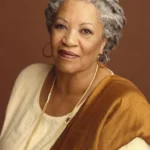Toni Morrison’s Beloved
Chapter-wise Summary and Important Characters Analysis
Introduction: Toni Morrison’s Beloved
Toni Morrison’s Beloved, published in 1987, is a powerful and haunting novel set in the aftermath of the American Civil War, following the life of Sethe, an escaped enslaved woman living in Cincinnati. We will explore the chapter-wise summary and important character analysis in the novel.
This novel explores themes of memory, trauma, and the legacy of slavery. Sethe is haunted by the ghost of her dead daughter, Beloved, whose presence disrupts the fragile peace Sethe has built for herself and her remaining family.
The novel is known for its narrative structure and symbolic use of the supernatural. Beloved’s return, both literal and metaphorical, serves as a manifestation of Sethe’s unresolved guilt and the collective trauma of the Black community after slavery. Through vivid imagery and poignant prose, Morrison delves deep into the emotional and psychological scars left by slavery, as well as the struggle for identity, community, and belonging.
Beloved is widely regarded as one of the most significant works in American literature, earning Morrison the Pulitzer Prize for Fiction in 1988 and later contributing to her the Nobel Prize in Literature in 1993. The novel’s exploration of history, motherhood, and the complexities of personal and collective memory remains relevant and deeply resonant.
About the Author:

Toni Morrison (1931–2019) was a highly acclaimed American novelist, essayist, editor, and professor, best known for her powerful exploration of African American identity, history, and culture. Born as Chloe Ardelia Wofford in Lorain, Ohio, she adopted the name Toni from her baptismal name, Anthony.
Morrison’s writing is celebrated for its poetic language, deep psychological insight, and unflinching portrayal of the Black experience in America. Her most famous works include Beloved (1987), Song of Solomon (1977), and The Bluest Eye (1970). In Beloved, she explores the legacy of slavery and its emotional toll through the life of a formerly enslaved woman, Sethe.
She was the first African American woman to win the Nobel Prize in Literature in 1993 and received numerous awards, including the Pulitzer Prize for Beloved. As an editor at Random House, she also championed the works of other Black writers.
Toni Morrison’s legacy is through her groundbreaking literary contributions, her advocacy for racial and social justice, and her profound influence on generations of writers and readers.
Here is a chapter-wise summary of Toni Morrison’s Beloved:
Part One
-
Chapter 1
-
The novel opens with the haunted house at 124, where Sethe lives with her daughter, Denver. The house is haunted by the ghost of Sethe’s deceased daughter. The community shuns Sethe because of the haunting.
-
-
Chapter 2
-
Sethe recalls her escape from slavery at Sweet Home, a plantation where she was enslaved. She reflects on her painful experiences, including the loss of her children, and the brutality of the system that made her kill her daughter to spare her from being captured.
-
-
Chapter 3
-
A mysterious woman named Beloved appears on the doorstep of 124. She is soon recognized as the manifestation of Sethe’s deceased daughter.
-
-
Chapter 4
-
Sethe, Denver, and Beloved begin to bond. Beloved’s strange behavior and memories create a sense of tension and unease.
-
-
Chapter 5
-
The presence of Beloved seems to consume Sethe, as she grows obsessed with the spirit. Denver becomes more isolated, feeling rejected by her mother.
-
-
Chapter 6
-
The novel’s narrative shifts to include flashbacks of Sethe’s time at Sweet Home, her relationships with fellow slaves, and the trauma she endured.
-
-
Chapter 7
-
Sethe’s memories of her dead children, particularly the ones she lost during her time in slavery, become more vivid. The ghost of Beloved becomes more real, physically interacting with Sethe and Denver.
-
-
Chapter 8
-
Denver, feeling neglected by Sethe, ventures outside the house to ask for help from the community. She returns with a woman named Ella, who speaks of the painful legacy of slavery.
-
Part Two: Toni Morrison’s Beloved
-
Chapter 9
-
The character of Paul D, a former slave from Sweet Home, enters the narrative. He forms a romantic relationship with Sethe, and together, they try to rebuild their lives.
-
-
Chapter 10
-
Paul D’s memories of Sweet Home and his trauma are revealed. He is deeply affected by Sethe’s actions regarding her child’s death.
-
Chapter 11
-
Sethe’s life becomes more complicated as she tries to care for both Paul D and Beloved. The community’s disapproval of Sethe continues.
-
Chapter 12
-
Beloved’s hold on Sethe tightens, and she begins to deteriorate physically and mentally. Paul D tries to help Sethe but is emotionally and physically drained.
-
Chapter 13
-
Sethe continues to care for Beloved, despite her growing dependence on Sethe, and the emotional toll it takes on the family.
-
Chapter 14
-
Paul D leaves Sethe, unable to cope with the weight of the past and Beloved’s presence. Sethe is left alone with Beloved, and her mental state deteriorates further.
-
Chapter 15
-
Denver begins to take responsibility for herself and for Sethe, seeking help from the outside world.
-
Chapter 16
-
The history of Sethe’s family, including her mother and grandmother, is explored, revealing the cycles of trauma passed down through generations.
-
Chapter 17
-
Denver’s growth continues as she seeks out the help of a local woman, who offers to help her family escape the suffocating grip of Beloved.
Part Three: Toni Morrison’s Beloved
- Chapter 18
-
As Sethe’s obsession with Beloved deepens, the presence of Beloved becomes overwhelming. Sethe’s world begins to collapse around her as she loses the ability to care for herself or Denver.
-
Chapter 19
-
Denver begins to understand the destructive power of Sethe’s obsession and realizes that she must take action to protect her family.
-
Chapter 20
-
Denver, now more independent, seeks out help and confronts the community for their abandonment of Sethe.
-
Chapter 21
-
The community begins to come together, helping to exorcise the spirit of Beloved from 124. Sethe, now broken, is left to rebuild her life.
-
Chapter 22
-
Sethe confronts her past and the choices she made. She reflects on her relationships, her guilt, and the enduring trauma of slavery.
-
Chapter 23
-
Sethe’s life begins to take a new turn as she accepts the painful truths of her past and the reality of moving forward.
-
Chapter 24
-
Sethe, still haunted by the memory of Beloved, begins to show signs of recovery. Denver, empowered by her efforts to save her family, starts to grow into a more self-sufficient individual. The community, which had once ostracized Sethe, begins to reunite around her.
-
Chapter 25
-
As Sethe’s connection with Beloved starts to weaken, Beloved’s physical form begins to fade. This chapter emphasizes the sense of relief and loss as Sethe moves toward healing, though the past continues to cast a long shadow over her.
-
Chapter 26
-
Sethe’s struggle to understand her past and reconcile with it continues. Her relationship with Denver grows stronger as they both navigate the complicated path of recovery. Sethe starts to grapple with the impact of her past actions, particularly her choice to kill her child rather than let her be captured.
-
Chapter 27
-
In this chapter, Sethe experiences a profound sense of loss and acceptance. She begins to understand that the ghost of Beloved is not just a literal manifestation but also a symbol of the trauma and guilt that have consumed her. This realization marks a shift in Sethe’s ability to cope with her past.
-
Chapter 28
-
The narrative touches on the communal nature of healing. The women in the community, who had previously distanced themselves from Sethe, begin to return to her, helping her confront the wounds left by slavery. Denver’s role in this process grows more significant as she becomes a key figure in the healing process for her mother and the community.
-
Chapter 29
-
Sethe’s confrontation with her past reaches a climactic moment, where she recognizes that she must let go of her guilt and the memory of Beloved to move forward. The community’s efforts help Sethe release her emotional burden, and Beloved’s presence begins to diminish.
-
Chapter 30
-
The final chapters offer a sense of closure as Sethe, Denver, and the community come together. Sethe reflects on the importance of moving forward while acknowledging the deep scars left by slavery. Though the novel ends with no clear resolution or complete peace, there is a sense of hope that healing is possible.
Conclusion: Toni Morrison’s Beloved
Beloved is a deeply layered novel about the psychological and emotional aftermath of slavery. The novel’s non-linear structure, use of symbolism, and focus on memory and trauma provide an intense exploration of the complexities of personal and collective histories. By the end of the novel, we find that the characters have begun the slow process of healing, but the scars of slavery will always remain part of their lives.
This chapter-by-chapter summary gives an outline of the main events and themes. But I suggest that the full depth and richness of Morrison’s narrative can only be fully appreciated through a detailed reading of the novel itself.
Important characters in Toni Morrison’s Beloved:



